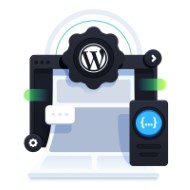WordPress as a Headless Content Management System (CMS) and GraphQL API
Discover the power of WordPress as a headless CMS. Learn how to set it up from scratch, migrate existing sites, and leverage its content editing experience. Boost performance and security while building with modern JavaScript frameworks. Take advantage of WordPress’s flexibility without compromising on frontend design. Join Kevin Cunningham in this comprehensive course.
WordPress has been around for a long time and powers a huge number of sites.
Just because WordPress isn’t brand new doesn’t mean it can’t get the job done!
Running WordPress as a Headless CMS gives you the benefit of a great content creation experience on the back end with the powerful Gutenberg editor while allowing you to use a modern JavaScript framework on the front-end.
In this course, Kevin Cunningham will guide you through setting up WordPress as a headless CMS from scratch, as well as migrating from an existing WP site. You’ll get practice with different WordPress content types, implement a GraphQL endpoint for querying data, and backup & deploy your site. All the while, you’ll deepen your understanding of how headless WordPress approaches the relationship between content & rendering.
Using WordPress as a headless CMS turns it into a datasource ready to work with Gatsby, Next.js, or whatever else you want to build with. Your and your clients will be able to take advantage of WordPress’s content editing experience, without having to settle for a cookie-cutter theme on the frontend.
With WordPress being decoupled from the rendered site, the database isn’t hit for every request. This means faster performance and more security against WordPress exploits. You don’t even have to host the editor at the same domain as the published site.
Course Content
Configure and Start a WordPress Instance using Local
Explore Pages, Tags, and Taxonomies in the WordPress JSON Route
Create and Explore a Single WordPress Post Through Gutenberg and the REST API
Extend a WordPress REST API to Register a Comments field on the Post GET API
Challenge: Extend the REST API
Add a Custom Post Type in WordPress with the CPT UI Plugin
Compare the Gutenberg Editing Experience with the Resulting REST API Structure
Expose Gutenberg Blocks to the REST API with the wp-rest-blocks Plugin
Filter Blocks Types that are Exposed in Gutenberg for a Predictable Headless WordPress API
Add the Advanced Custom Fields (ACF) Plugin and Expose those Fields to the REST API
Write Markdown Posts in WordPress with the WordPress Markdown Editor Plugin
Create and Test a GraphQL Endpoint for WordPress with wp-graphql
Add a Custom Post Type to the GraphQL Headless WordPress API Endpoint
Expose Gutenberg Blocks to the Headless WordPress GraphQL Endpoint
Expose WordPress Advanced Custom Field (ACF) Plugin Data to the GraphQL Endpoint
Build a GraphQL Query with Exactly the Data you need for a Posts Page
Add Fake Data to a WordPress Instance with the Faker Press Plugin
Backup Your Content and Custom App Logic in a WordPress Instance
Replicate a Remote WordPress Site Locally by Importing Content and Logic
Add Comments to a Headless WordPress Post using Application Passwords
Manage Media Assets in a Headless WordPress Site using the Cloudinary WordPress Plugin
User Reviews
Be the first to review “WordPress as a Headless Content Management System (CMS) and GraphQL API”
You must be logged in to post a review.







There are no reviews yet.